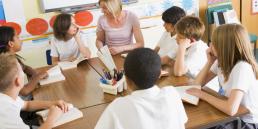An Ofsted reading webinar once discussed the importance of reading well as being a gateway to the wider curriculum and accessing learning to the full; that being able to read well opens a door to enjoyment and longer fulfilment; and that the purpose of reading is to “Move from learning to read to reading to learn”.
And it is in the definition of that final verb “to learn” where great schools and reading leaders stand apart from the ‘good’. They understand that reading to learn goes far beyond accessing and learning the national curriculum, far beyond the acquisition of knowledge, facts, and language to be applied in further educational work or discussion, and even beyond developing the joy of reading.
What, how, why
Most schools and reading leaders know what they do in relation to teaching reading: teach children to read and comprehend texts fluently and confidently and develop a love of reading.
Good schools and reading leaders know how they teach reading: an effective reading curriculum; development of language and communication in the early years; implementation of a robust, systematic, synthetic phonics scheme to ensure children can decode fluently; a consistent approach in explicitly teaching the reading domains; unpicking linguistic morphology and etymology; providing a wealth of rich and challenging texts; not to mention the plethora of reading incentive schemes that schools employ to encourage an engagement in reading.
But great schools and reading leaders, know something even more significant, something which drives a culture and underpins every decision they make about their reading curriculum. They also know why they teach reading, and more importantly why it is vital to instil a love of reading in every child in their care. (Sinek, S. (2011). Start with why).
Reading to learn
The work of Jenni Wyrill, a Director of Teaching and Learning for a Trust in Barnsley, who devotes her research and energy in to ensuring the deep, underlying philosophy which will lead to a love of reading, is shared across the schools in the Trust. She combines her academic research with guidance as to how effective pedagogy can ensure that school’s implementation of the teaching of reading is totally effective. The strategic implementation of their high-quality reading curriculum across the Trust enhances all aspects of learning throughout the schools. Despite my many years of experience, I learn something new and exciting every time I have the privilege to work with the Trust.
Jenni asserts that if we are truly reading to learn then through our texts, we should be learning about ourselves, our communities, our societies, our world. Through the characters’ thoughts, we should be learning about our own viewpoints, opinions and beliefs on issues which matter. Through the characters’ dialogue, we should be learning how to find our own voice to speak out for ourselves and others about issues that matter; and through the characters’ actions, we should be learning how we ourselves can rise, stand together, and take action for, or against, issues which matter in our world.
Thus, great reading leaders understand that this learning goes even beyond developing the joy of reading, for learning in this way is not always joyful. It is sometimes uncomfortable and challenging; it makes us question what we thought we knew and question those around us. But it is in this learning where the “doors to longer fulfilment” truly begin to open. It is where the 60% of young offenders who have speech, language, and communication needs (SLCN), undiagnosed prior to offending, find the ability to voice their frustrations and turmoil. It is where every child is introduced to, and has the capacity to contribute to, “the best that has been thought and said” (Ofsted, 2019), resulting in the representation of everyone, not just the elite. It is a future where children understand and empathise with the world around them. It is not a future where nearly half of disadvantaged pupils leave school unable to read well, or where “those who do not learn to speak, read and write fluently and confidently are effectively disenfranchised” (English National Curriculum purpose of study).
Surely, it must be our goal to create a world where we, as educators, ensure that ‘Every student must glimpse, as much as possible, the power that comes from the world that reading can bring to light’ (Doug Lemov, Reading reconsidered 2016)
Developing the love of reading
My own memories of learning to read via the ‘look and say’ methodology in the 1950s was just that: I looked at a picture of a pig called Master Willy shown to me by my teacher, Miss Lovell. As she said, ‘Master Willy’ I repeated ‘Master Willy’. Result! I was on my way to getting my first book: ‘A visit to Updown’ in the Beacon Reader series. After reading the names of six characters correctly to Miss Lovell in the infant class, I was given a “St Bruno” tobacco tin, which had the wax crayons pushed out and replaced by my flashcards. Once I could read the names of six of the characters from the story together with three conjunctions, three adjectives and three verbs, I took the tin home to practise. I could decode print; I could read the words without the picture cues and I could begin to enjoy the stories: chuckling when Percy the Bad Chick and Master Willy the pig trampled the washing in the mud; or sighing with relief when Miss Tibbs the cat was returned safely after running away from the farm at Updown.
I came to love reading through purely being read to and the sharing of books: sitting at my desk (no carpets in those days) during the afternoon, listening to my teacher read texts such as The Secret Garden, The Water Babies and the one which sealed my love of reading The Hobbit. I was also lucky that my large family (one of eleven children) with a mother as a librarian, continually read to each other with memories of stories such as Alison Uttley’s Adventures of Sam Pig, Anne of Green Gables and Just William.
The Real Book approach
So, as a primary school class teacher in the 1970s, I was inspired by Margaret Meek’s approach to reading. The ‘Real Book’ approach, using quality texts to teach children to read, resonated totally with how I had moved from ‘decoding’ Beacon Readers to ‘learning to read’. Her work absolutely valued the quality of children’s literature. However, like so many highly innovative education ideas, it needed to win the hearts and minds of teachers to implement this effectively. Sadly, this was not always the case and I witnessed first-hand the demise of the ‘The Real Book’ approach because some only skimmed the surface of her work and misinterpreted the philosophy, expecting children to learn to read by a process of osmosis as they sat with an open book in the reading corner with not a phoneme in sight and not a clue what they were doing.
In 2021 there may be the simple secret to developing this love of reading which has been staring us in the face all along. Yes, of course develop the vital language and communication in the early years. Yes, systematically teach children how to decode and make sense of phonemes within an effective programme. Yes, consistently develop the reading domains to ensure children understand what they are reading. But if you truly want your children to love reading and truly “read to learn” rather than just “learn to read”, then maybe it’s time to strip back the gimmicks and simply give ourselves over to reading again. Let’s exercise great care, choosing books from which we will all learn deeply; impart our own genuine love for reading with passion; share that glorious bond of time slipping away as, in that moment, the pages of the book become part of our very existence; commit to learning together and having the knowledge to link themes across time and globe to make them relevant and powerful in our lives today; understand what the ultimate purpose of reading is and why, for the success of their futures, it is vital that this is achieved.
And thus, when developing a love of reading in school, rather than starting with what you do and working from the outside in as illustrated here:
I am going to read you a book from the “What I am reading this week” list. You are going to read sections of it in guided reading (some of you will be outside reading 1 to 1 or catching up on your phonic learning), you will unpick it, highlight vocabulary, retrieve information from it, try and infer from it, and develop your reading skills. You can then choose other books like it from the library, fill in your reading journal, get your parents to sign it and write a review. I will give you stickers/Dojo’s/points to award you for reading. Are you excited? Do you want to read the book?”
If you truly understand your purpose and why, you will begin to start with this and work from the inside out:
I want to open up the world to you; I want you to walk in the footsteps of others and experience all that the world and time has to offer. I want to talk with you, learn with you, laugh with you, cry with you, dream and hope for the future with you, and truly share this experience with you. So, I have spent time really carefully choosing a book, just for us, which will allow us to do all this. Which will allow us to think about the things that matter to us and help us think about how we can achieve great things. Are you excited? Do you want to read the book?’
On that note, I am off to the reading corner with a ‘Real Book’.



